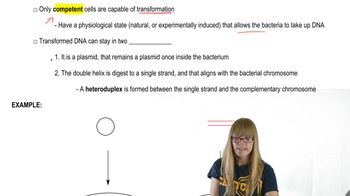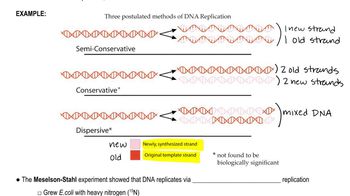Table of contents
- 1. Introduction to Genetics51m
- 2. Mendel's Laws of Inheritance3h 37m
- 3. Extensions to Mendelian Inheritance2h 41m
- 4. Genetic Mapping and Linkage2h 28m
- 5. Genetics of Bacteria and Viruses1h 21m
- 6. Chromosomal Variation1h 48m
- 7. DNA and Chromosome Structure56m
- 8. DNA Replication1h 10m
- 9. Mitosis and Meiosis1h 34m
- 10. Transcription1h 0m
- 11. Translation58m
- 12. Gene Regulation in Prokaryotes1h 19m
- 13. Gene Regulation in Eukaryotes44m
- 14. Genetic Control of Development44m
- 15. Genomes and Genomics1h 50m
- 16. Transposable Elements47m
- 17. Mutation, Repair, and Recombination1h 6m
- 18. Molecular Genetic Tools19m
- 19. Cancer Genetics29m
- 20. Quantitative Genetics1h 26m
- 21. Population Genetics50m
- 22. Evolutionary Genetics29m
8. DNA Replication
Overview of DNA Replication
Problem 1d
Textbook Question
In this chapter, we focused on how DNA is replicated and synthesized. We also discussed recombination at the DNA level. Along the way, we encountered many opportunities to consider how this information was acquired. On the basis of these discussions, what answers would you propose to the following fundamental questions? How was it demonstrated that DNA synthesis occurs under the direction of DNA polymerase III and not polymerase I?
 Verified step by step guidance
Verified step by step guidance1
<Step 1: Understand the roles of DNA polymerase I and III. DNA polymerase I was initially discovered and thought to be responsible for DNA replication, but it was later found to have a role in DNA repair and processing of Okazaki fragments. DNA polymerase III is the main enzyme responsible for DNA synthesis during replication.>
<Step 2: Review the experimental evidence. Researchers conducted experiments using mutant strains of bacteria that lacked functional DNA polymerase I. These mutants were still able to replicate their DNA, suggesting that another enzyme was responsible for DNA synthesis.>
<Step 3: Consider the discovery of DNA polymerase III. Further studies identified DNA polymerase III as the enzyme responsible for the bulk of DNA synthesis. This was demonstrated through in vitro experiments showing that DNA polymerase III could synthesize DNA at a much faster rate than DNA polymerase I.>
<Step 4: Analyze the biochemical properties. DNA polymerase III has a higher processivity and fidelity compared to DNA polymerase I, making it more suitable for the rapid and accurate replication of the entire genome.>
<Step 5: Summarize the findings. The combination of genetic, biochemical, and in vitro studies provided strong evidence that DNA polymerase III, not DNA polymerase I, is the primary enzyme responsible for DNA replication in cells.>
Recommended similar problem, with video answer:
 Verified Solution
Verified SolutionThis video solution was recommended by our tutors as helpful for the problem above
Video duration:
2mPlay a video:
Was this helpful?
Key Concepts
Here are the essential concepts you must grasp in order to answer the question correctly.
DNA Polymerases
DNA polymerases are enzymes responsible for synthesizing new DNA strands by adding nucleotides to a growing chain. In prokaryotes, DNA polymerase III is the primary enzyme for DNA replication, while DNA polymerase I plays a role in removing RNA primers and filling in gaps. Understanding the distinct functions of these polymerases is crucial for grasping how DNA synthesis is directed during replication.
Recommended video:
Guided course

DNA Proofreading
Experimental Evidence
Demonstrating the specific roles of DNA polymerases often involves experimental evidence, such as genetic mutations or biochemical assays. For instance, studies using temperature-sensitive mutants or inhibitors can show that DNA synthesis halts when DNA polymerase III is inactive, while polymerase I does not compensate for this loss. Such experiments provide insight into the functional hierarchy of these enzymes during DNA replication.
Recommended video:
Guided course

Transformation
Replication Fork Dynamics
The replication fork is the area where DNA unwinds and new strands are synthesized. DNA polymerase III operates at the replication fork, adding nucleotides in a 5' to 3' direction, while coordinating with other proteins to ensure efficient replication. Understanding the dynamics of the replication fork helps clarify why DNA polymerase III is essential for synthesizing the leading and lagging strands during DNA replication.
Recommended video:
Guided course

Semiconservative Replication

 5:02m
5:02mWatch next
Master Directionality with a bite sized video explanation from Kylia Goodner
Start learning



